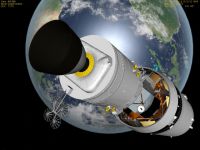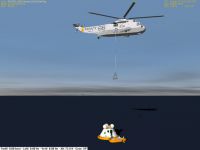Difference between revisions of "AMSO"
| Line 4: | Line 4: | ||
}} | }} | ||
| − | '''AMSO (Apollo Mission Simulator for Orbiter)''' is an add-on for Orbiter Space Flight Simulator by Martin | + | '''AMSO (Apollo Mission Simulator for Orbiter)''' is an add-on for Orbiter Space Flight Simulator by Martin Schweiger. |
It reproduces the historical flights of the American Apollo Project for the exploration of the Moon from 1968 to 1972, from Apollo 8 to Apollo 17. | It reproduces the historical flights of the American Apollo Project for the exploration of the Moon from 1968 to 1972, from Apollo 8 to Apollo 17. | ||
Revision as of 16:44, 27 March 2008
|
Project home: ACSofts AMSO homepage |
AMSO (Apollo Mission Simulator for Orbiter) is an add-on for Orbiter Space Flight Simulator by Martin Schweiger. It reproduces the historical flights of the American Apollo Project for the exploration of the Moon from 1968 to 1972, from Apollo 8 to Apollo 17.
The main purpose of AMSO is to give users the possibility to live in first person this great challenge of our century, letting them, in the same time, choose the way they prefer to succeed. The user will be able to accomplish his mission flying the vessels completely manually (and this is a big challenge), or with the aid of some clever autopilot programs, that reproduce some features of real Apollo guidance system, created by Lazy-D; those will assist the Commander in some crucial phases of the flight, without depriving Orbinauts of their fun.
One of it’s greater quality is the astonishing graphic, which allows the user to enjoy a complex meshing and texturing work without loosing notably Frames Per Second; an example is the accurate Virtual Cockpit for both CSM and LM, for the moment unusable, but so accurate that gives a great immersion in phases of flight like docking and landing. For Docking manoeuvre a full-working and realistic Crewman Optical Alignment Sight (COAS) is provided on both CSM and LM.
Complex moon scenarios will allow pioneers to explore the surface of historical landing locations, with craters, mountains, rilles and particular soil characteristics; astronauts, with completely new meshes and fully movable visors, will have the possibility to plant flag, deploy SWC and ALSEP experiments, drill the soil and collect rock samples dynamically generated, and on the way back to Earth, during J-type missions, to retrieve useful materials from the fully simulated CSM Sim-bay.
And if a malfunction occurs? Crew members will have the possibility to test their nerves and skills facing a wide range of dangerous situation, from a simple autopilot malfunction to the Cryo Tank explosion aboard Apollo 13. Will you be able to abort the mission in time? Or to use the DPS engine of LM to get back to Earth?
Basic features
- Simple user interface, consisting of only few keys
- Complex mission simulation, especially covering the lunar surface activities.
- Crew can die, terminating your whole mission.
Version 1.11
This AMSO version supported the whole basic mission profile, including detailed lunar surface activities and recovery. The landing sites got propped up with dynamically created rocks in various sizes.
Version 1.12
This version of AMSO saw dramatic changes in its visual appearance, showing new photo-realistic meshes. The most dramatic change happened for the landing sites, now showing nearly realistic 3D terrains. Also the initially simple launch sequences saw great upgrades. Also the J-missions (Apollo 15 and following) now have a SIM bay which will can be deployed. It was released on Monday, July 16, 2007.
- Video of the new launch sequence, with focus on the LUT arms
- Video of the new launch sequence during night
- Video of a day launch in the new version
- Video of the Apollo 11 landing
Version 1.17
- New ATC sounds customization model. Now any number of ATC can be played at any times (also at any altitude for LM landing), determined by ATC file names themselve. There is ATC synchronized on specific events like for example, LM PDI and landing and ATC synchronized on the GET. ATC synchronized on GET can be disabled with "Ctrl-K".
- New pre-launch sound capability: now it is possible to play a pre-countdown sound, starting exactly at minus 5mn and in this case, the last 10 seconds countdown and liftoff will be automatically triggered.
- First sample soundpack extension for Apollo 11, featuring the new pre-launch sound capability, complete ATC for LM PDI and LM ascent Moon orbit insertion and many other new ATC.
- Added a camera shaker on Apollo and LM vessels. Different vibration ratios in function of the configuration. Staging simulation, active during all main engine thrust and during atmospheric entry.
- Added metallic particles ejection effect during all staging, including a special one during the LM ascent liftoff.
- Revised Lunar Rover, with fully animated wheels (rotation & direction), leaving dust trail when rolling, with camera shaker function in virtual view.
See also


























